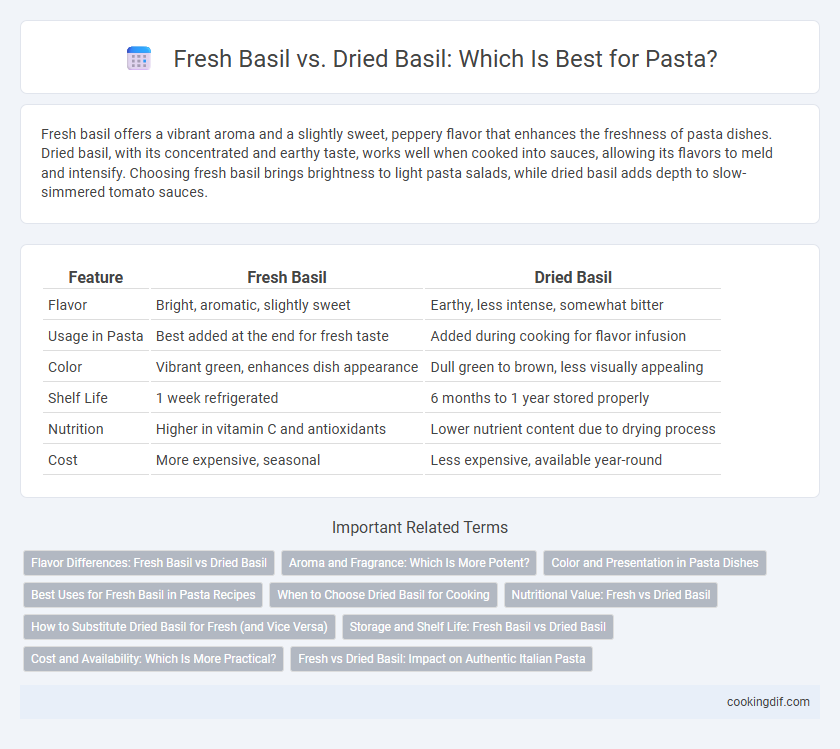Fresh basil offers a vibrant aroma and a slightly sweet, peppery flavor that enhances the freshness of pasta dishes. Dried basil, with its concentrated and earthy taste, works well when cooked into sauces, allowing its flavors to meld and intensify. Choosing fresh basil brings brightness to light pasta salads, while dried basil adds depth to slow-simmered tomato sauces.
Table of Comparison
| Feature | Fresh Basil | Dried Basil |
|---|---|---|
| Flavor | Bright, aromatic, slightly sweet | Earthy, less intense, somewhat bitter |
| Usage in Pasta | Best added at the end for fresh taste | Added during cooking for flavor infusion |
| Color | Vibrant green, enhances dish appearance | Dull green to brown, less visually appealing |
| Shelf Life | 1 week refrigerated | 6 months to 1 year stored properly |
| Nutrition | Higher in vitamin C and antioxidants | Lower nutrient content due to drying process |
| Cost | More expensive, seasonal | Less expensive, available year-round |
Flavor Differences: Fresh Basil vs Dried Basil
Fresh basil offers a vibrant, sweet, and slightly peppery flavor that enhances the brightness of pasta dishes, while dried basil provides a more concentrated, earthy, and slightly bitter taste due to the drying process. The aromatic oils in fresh basil are more potent and volatile, giving a fresher and more complex flavor profile compared to the subtle, muted notes found in dried basil. Using fresh basil in pasta recipes emphasizes lively herbaceous flavors, whereas dried basil works best when cooked longer to release its deeper, mellow essence.
Aroma and Fragrance: Which Is More Potent?
Fresh basil delivers a vibrant, sweet aroma with intense herbal notes due to its higher concentration of essential oils, making it more potent in fragrance than dried basil. Dried basil, while more concentrated in flavor, loses much of its fresh, green scent during the drying process, resulting in a milder and earthier aroma. For pasta dishes, fresh basil elevates the sensory experience by infusing bright, aromatic freshness that dried basil cannot fully replicate.
Color and Presentation in Pasta Dishes
Fresh basil provides vibrant green leaves that enhance the visual appeal of pasta dishes, creating an inviting and fresh presentation. Dried basil tends to lose its bright color during processing, resulting in a muted, dull green that blends into the sauce rather than standing out. Using fresh basil as a garnish maintains the dish's color contrast, making the pasta look more appetizing and visually appealing.
Best Uses for Fresh Basil in Pasta Recipes
Fresh basil enhances pasta dishes with its vibrant aroma and delicate, sweet flavor, making it ideal for recipes like Caprese pasta, pesto, and light tomato sauces. Its tender leaves release essential oils that elevate the taste and freshness when added just before serving. Unlike dried basil, fresh basil maintains a bright green color and a crisp texture, perfectly complementing fresh ingredients and simple pasta preparations.
When to Choose Dried Basil for Cooking
Dried basil is ideal for slow-cooked pasta sauces like marinara or Bolognese because its flavor intensifies and infuses over time, providing a deep, aromatic base. It retains potency longer in recipes requiring prolonged simmering, making it perfect for enhancing hearty tomato-based dishes. Use dried basil when fresh basil is unavailable or when a consistent, concentrated herb flavor is desired throughout the cooking process.
Nutritional Value: Fresh vs Dried Basil
Fresh basil contains higher levels of essential oils, vitamins A, C, and K, and antioxidants compared to dried basil, which loses much of these nutrients during the drying process. The nutritional density of fresh basil supports better anti-inflammatory and immune-boosting benefits, making it a healthier choice for pasta dishes. Dried basil, while more concentrated in flavor, offers fewer nutrients but remains a convenient herb option with a longer shelf life.
How to Substitute Dried Basil for Fresh (and Vice Versa)
To substitute dried basil for fresh in pasta dishes, use one-third the amount of dried basil since it has a more concentrated flavor; for example, 1 teaspoon of dried basil replaces 1 tablespoon of fresh. When swapping fresh basil for dried, triple the quantity of dried basil called for in the recipe to achieve a comparable taste intensity. Fresh basil is ideal for finishing pasta with bright, herbal notes, while dried basil is better suited for long-cooked sauces where flavors meld and intensify over time.
Storage and Shelf Life: Fresh Basil vs Dried Basil
Fresh basil requires refrigeration and typically lasts up to one week before wilting, making it ideal for immediate use in pasta dishes. Dried basil, stored in an airtight container in a cool, dark place, can retain potency for up to 1-3 years, providing long-term convenience for seasoning pasta sauces. Proper storage methods significantly impact the flavor intensity and shelf life of both fresh and dried basil in culinary applications.
Cost and Availability: Which Is More Practical?
Fresh basil typically costs more than dried basil due to its perishable nature and seasonal availability, often making dried basil the more budget-friendly choice for home cooks. Dried basil, available year-round in most grocery stores, provides consistent availability and a longer shelf life, reducing waste and making it more practical for frequent use. For recipes like pasta sauces where a strong, fresh herb flavor is desired, fresh basil is preferred despite the higher cost and limited access.
Fresh vs Dried Basil: Impact on Authentic Italian Pasta
Fresh basil delivers a vibrant aroma and bright flavor essential for authentic Italian pasta, particularly in dishes like basil pesto or Caprese pasta, where its natural oils enhance the dish's freshness. Dried basil, while convenient and longer-lasting, offers a more subdued taste and slightly earthy notes that can alter the delicate balance of traditional recipes. Choosing fresh basil preserves the herb's essential oils and bright green color, directly contributing to the characteristic authenticity and visual appeal of Italian pasta dishes.
fresh basil vs dried basil for herbs Infographic

 cookingdif.com
cookingdif.com